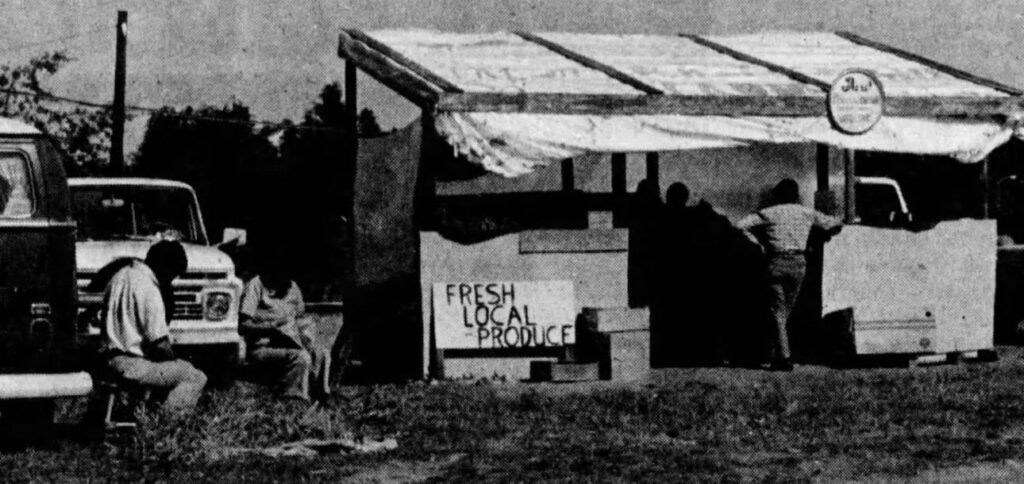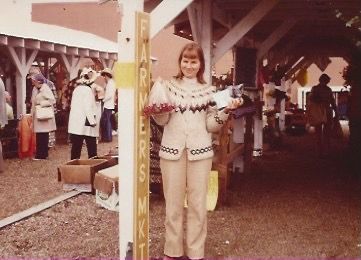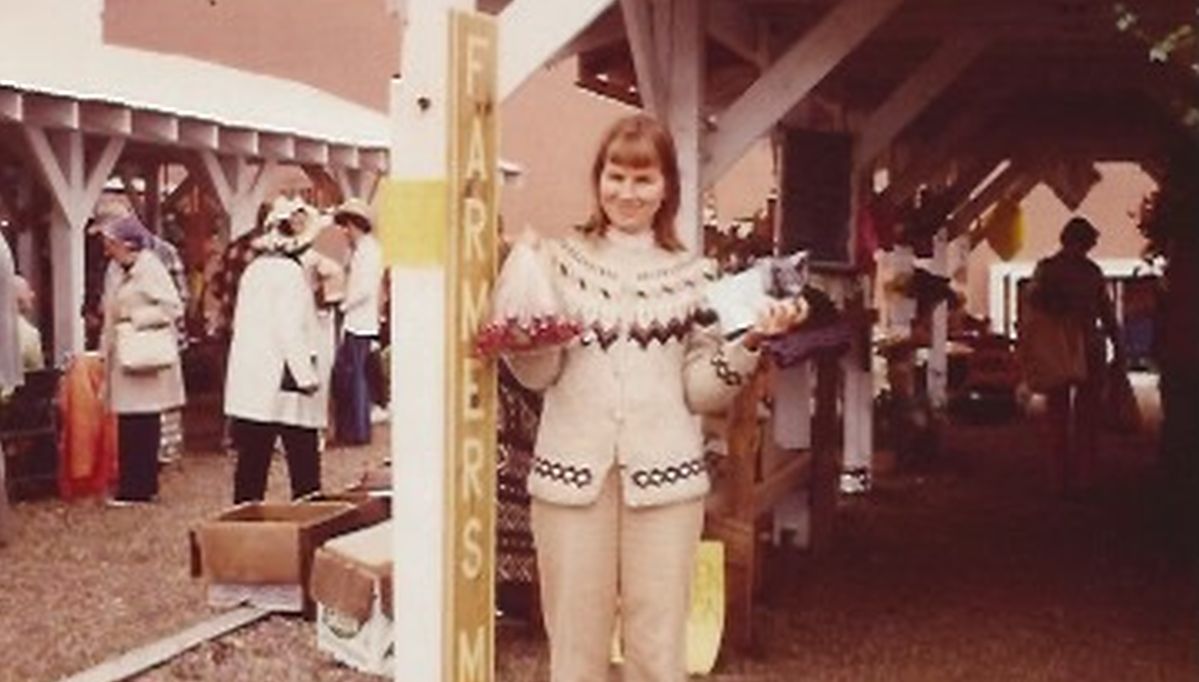FOOD
Olympia Farmers Market
By Becky Liebman

Memory can be capricious. Yet, here is a claim I believe I can make with certitude: Olympia Farmers Market grew and thrived—in spite of those of us who were trying to make it grow and thrive!
I make this loving observation as someone who was a Market manager in the early days, and who later served as board member and board president during many colorful, contentious years. The fights were good fights, about the fees we charged ourselves, stall allocations, what defined “locally produced,” how we dealt with non-local products, with craft vendors, even the location of the Market itself, each a growing pain that had to be addressed.
Details of Market twists and turns, heartaches and celebrations (up to 1995) have been beautifully told by market co-founder Steve Wilcox in History of the Olympia Farmers Market. Steve’s perspective is important. He and others served as a Rosetta Stone, linking the countercultural hopes of the late ’60s and early ’70s to the know-how of local farmers and individuals connected to the Senior Center.
Steve writes, “In 1971, I was part of a group of local people who formed the Olympia Food Conspiracy Co-op. Inspired by other examples of food co-ops, namely the Berkeley Food Conspiracy and the Puget Consumers Co-op, we created a democratically-run, volunteer-based cooperative food buying community . . . As the membership grew, so did a system of neighborhood buying clubs.”
Years later, Steve and VISTA volunteer Dan Kapsner along with his Evergreen intern Claudia Sepp, all relatively recent immigrants, plus long-time locals who got things done, like Lu Hall, Mary Towne, and Homer Hedgepath, created the Market in the spring of 1975. The Olympia Food Conspiracy provided the paperwork for their incorporation. Still another link in a chain of good things!
While Olympia had a farmers’ market in the 1930s and ’40s, the current Market had its baby beginnings on a swatch of ground in 1975, in Lacey. It moved the next year to a parking lot at Capitol Lake, now the present-day Heritage Park. A few years later, it would move to the parking lot of Western Farmers on Plum Street and Union, and from there to the old Yard Bird’s site on north Capitol Way, and at long last to its permanent home on Port of Olympia property.
In this piece, I simply present a snapshot of what it looked like the summer of 1977, the year I connected to the Market.
I had just bumped my way through college, which I’d started six years earlier as a wide-eyed eighteen-year-old who’d come from a small midwestern town in 1971 to attend the inaugural year of The Evergreen State College. Newly graduated and earnestly stocking beer and groceries at the Handy Pantry, my potato farming Evergreen friend Gordon White told me the Market was looking for a new manager to begin its second year in Olympia.
I contacted their former manager, Claudia Sepp, and became appointed by . . . well, by the two of us! It did not enter our minds that this would properly be a deliberative process by . . . what’s the word . . . a board? Claudia filled me with information, gave me the receipt book, the money box, and a list of addresses which I used to convene a meeting. Years later, Doris Cellarius, then president of the board, would regale me and others by saying, “I thought it strange to come back from a vacation and find a meeting was being called by someone I’d never met.” Somehow, the unconventional hiring process, which involved a very small stipend, worked out.
The early days presented a consummate catch-22 situation. Growers did not want to participate unless there were customers. Customers would not return if there wasn’t produce to buy. As manager, I considered myself a marketing genius: I would call numbers I found in the classified ads of the Daily Olympian with a pitch something like, “I see you’re selling cucumbers. Did you know we have a farmers market in Olympia, open every Friday and Saturday alongside Capitol Lake?” Slowly the word spread.

How I wish I had a real photograph of those tender beginnings! I was young and still clueless of the life of rural Washingtonians. If I close my eyes and search for wisps of memory that have been languishing for forty-five years, here’s what I see on that gravel parking lot:
—First, the white wooden cart that served as the Market’s main locus, built by Paul Klotzner, Yelm farmer by day, and by night the watchman of the state power house and heating plant, also located alongside Capitol Lake, and where he built the cart. He machined his own bolts for the project, an accomplishment that astonished me. From that wobbly cart, produce grown by senior citizens and young farmers (often with day jobs) was sold on commission with the help of wobbly volunteers from the Retired Senior Volunteer Program. This was the main source of income for the Market.
—The red and white pick-up truck of Harry and Ina Lyons, who truck farmed in the Nisqually Valley, with lots of strawberries and a bit of everything else. Ina was a sturdy farmer and born sales woman with a perfect permanent. She had met the shy, rock-solid Harry at a singles dance in Puyallup. Together, two of them provided a major source of produce those first few years, and were the go-to people when the Market needed help.
—The coincidentally blue pickup of Michelle Eberhart and her husband, both young blueberry farmers with a passel of kids. By the end of a sales day, Michelle often had blueberry stains on her own lips. It tickled me to think that she liked to eat blueberries.
—The homemade ornamental wishing well chained onto the back of Red Tyler’s ancient Buick sedan. Red was retired from his work in carnivals and construction, and proud of his status as a recovering alcoholic. He showed up every week with his mandolin, because it was someplace to go and also because once in a while, he sold one of those dang wells. He called me “Becky Babe” which made my young, feminist-self bristle, though I came to deeply appreciate him.
—The white, well-used pick-up of Jasper Martin, filled with the sweetest sweet corn from his farm in Maytown. White-haired, lean, bearded, Jasper was noteworthy for his early commitment to organic farming. Despite an age difference of forty years, I do believe I had a crush on Jasper.
—The odd assortment of trucks, station wagons, and card tables, involving people like Tom Carr and others who occasionally sold honey; the women who sold their book on natural dyeing of yarns from lichens; a red-headed Bob Ziegler collecting signatures to take the sales tax off of food; and Vinnie Russell who would sail in with—and quickly sell out of—aromatic home baked bread.
Oh, dear, who am I forgetting?!?
I could create a similar visual for the next year, when the Olympia Farmers Market moved to the gravel parking lot of a Western Farmers store, long since been replaced by several unpleasant looking office buildings. That would be the year, I think, when the younger, back-to-the-land farmers really began to make a difference in the amount of produce available for sale. Growers like Lou Johns, Betsie DeWreede, Grant Rostan.
I could describe the strawberry shortcake festival fundraiser and how when we ran out of forks, I discreetly fished some out of the garbage and took them to the nearby Shakey’s pizza parlor bathroom to wash them off for re-use. Or the story about how we started to build an open-sided structure to protect vendors and customers from the weather, and how a stop-work order was put on the early framing of the building the day before a big volunteer work party, and how Steve Wilcox put his jacket over the officious document so that we could proceed. I could also riff on a rough patch in the ’80s when there was an effort to move the Market to Lacey and the painful meetings we had during that time.
But those stories are long and Steve covered them in his opus. Instead, what I want you to know, dear reader, is the Market grew and thrived but not because of any well-orchestrated or informed strategic plan. So, what explains the Market’s life affirming success? I believe it happened because of the extraordinary power of the idea itself: fresh, local produce sold directly to customers in an area with a good mix of rural spaces and a medium-sized population. And from the energy and dreams of countless individuals who did the growing, schlepping, building, permit seeking, risk-taking, accounting, fork-washing, problem solving at tense meetings, and more. And from the beloved shoppers, especially in those early years, who supported the Market even when there was little to buy. They had good hearts, too, and their own dreams for better ways of doing things.
I know I’m leaving out so many others from 1977 due to the limitations of space and memory. I ask for forgiveness.
Meanwhile, I want to know what other fantastic institutions are out there, being born now, or yet to be born, that will help us create the community and resilience that we yearn for. I’m sure it’s out there . . . and it makes me smile with gratitude and hope.
We encourage readers to contact us with comments and corrections. Disclaimer

